Abstract
We present the investigation results of vibration characteristics of miniature stirling electric coolers, which can be used for compact HPGe spectrometers for space applications. Comparative assessment between three Stirling cycle coolers – two Ricor model K508 coolers and one Thales model RM3 cooler were done. In spite of the limited number of the coolers tested, the following conclusions can be made, that there are significant differences in the vibration characteristics between the various types of coolers and between coolers of the same type. To categorize the vibration characteristics of the coolers we carried out our tests by different methods in certified Vibroacoustic laboratory and BSI laboratory. The results obtained in our laboratory follow the same trends and give the same ranking as the test results obtained in the Vibroacoustic laboratory.
1. Introduction
The appearance of miniature Stirling electric coolers on the market has provide the development of a wide spectrum of nuclear physics devices base on High Purity Germanium (HPGe) detectors with application of those coolers [1]. The equipment for the precise radionuclide analysis in nuclear energetic and environment monitoring, medicine and geology, scientific research and other tasks is available on the market already [2-4]. The main restraint problem at the development and production of precise gamma spectrometric devices with application of electric coolers is the presence of the mechanical vibrations and their substantial impact to the energy resolution of HPGe detectors.
In MESENGER space project [5] electric cooler Ricor K508 [6] was used for cooling of HPGe detector. In work [7] we have demonstrated also the development results of the small-sized HPGe spectrometer for the space applications. At the power supply of 6.6 W on the electric cooler Ricor K508, cooled HPGe detector of N-type with registration efficiency of 38 %, the energy resolution of 2.9 keV and 4.0 keV by energy 122 and 1332 keV has been obtained, accordingly. At the switched off cooler the energy resolution was 2.0 keV and 3.0 keV, accordingly. The test results also have shown the considerable impact of Ricor K508 vibrations on the characteristics of the developed spectrometer, however, the level of those vibrations we have evaluated integrally only by their impact to the energy resolution of the spectrometer.
Recently the company Thales Cryogenics (France) has informed the development of one more type of the electric cooler RM3 which could be potentially applied for the creation of the small-sized spectrometers for the space applications [8]. However, its vibration characteristics are not specified as well. The purpose of the present work is the comparative investigations of the vibration characteristics of the electric coolers Ricor K508 and Thales RM3 by the direct methods for the inner specifications of their vibration characteristics, definition of the limits in those characteristics spread and determination of possible organization of the input control for the vibration parameters of the electric coolers before their application in the devices for the space investigations. The tests were made on the electric coolers: Ricor K508, N1; Ricor K508, N2; Thales RM3, N1.
2. Investigation of the vibration characteristics
The external view of the Thales RM3 and Ricor K508 miniature Stirling cycle coolers is shown in Fig. 1. Both the Ricor and Thales coolers are of similar size and weight and both have imbedded controllers. All coolers performance you can find in [6, 8].
Fig. 1Photograph of the Thales RM3 and Ricor K508 miniature Stirling cycle coolers
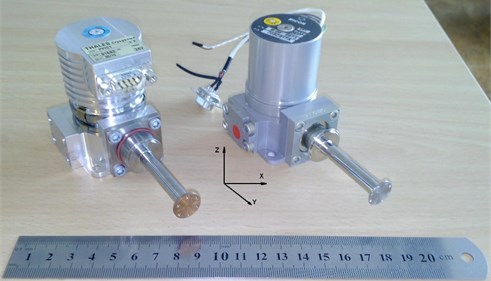
The investigation of the vibration characteristics of the coolers was made in the Vibroacoustic laboratory of the Diagnostics and Design Center in Riga [9], which is accredited by the Latvian National Accreditation Bureau (LATAK) [10]. Measurements were made with a Brüel&Kjær spectrum analyzer (model number 3560), operating in a three-dimension accelerometer mode. The orientation of axes relative to the electric cooler case, were as follows; X – perpendicular to the axes of cooler reels and cold finger; Y – along the cold finger axis; Z – along the cooler reel’s axis (see Fig. 1). The vibration acceleration dependence on frequency was measured as well as a summary value of the acceleration in each axis. The results are summarized in Table 1.
Table 1Vibration characteristics of the Stirling cycle coolers in three axes
Acceleration in range | RicorN1 X (m/s2) | Thales X (m/s2) | RicorN2 X (m/s2) | RicorN1 Y (m/s2) | Thales Y (m/s2) | RicoN2 Y (m/s2) | RicoN1 Z (m/s2) | Thales Z (m/s2) | RicorN2 Z (m/s2) |
Main frequency | 0.2 | 1.8 | 0.85 | 1.18 | 1.8 | 0.95 | 1.4 | 1.41 | 1 |
Second harmonic | 2.5 | 2.9 | 2.75 | 1.33 | 1.3 | 1.13 | 0.25 | 0.51 | 0.6 |
1...2 kHz | 1.25 | 1.1 | 0.5 | 1.4 | 1.08 | 0.4 | 1.9 | 1.28 | 0.58 |
2...3 kHz | 0.6 | 0.2 | 0.2 | 0.45 | 0.5 | 0.20 | 2.03 | 0.4 | 0.79 |
3...4 kHz | 0.45 | 1.15 | 0.1 | 0.4 | 0.4 | 0.32 | 1.4 | 0.75 | 0.45 |
4...5 kHz | 0.15 | 0.1 | 0.05 | 0.1 | 0.2 | 0.02 | 0.1 | 0.39 | 0.1 |
Summary Acceleration | 5.57 | 5.51 | 4.36 | 4.35 | 4.01 | 2.82 | 7.93 | 5.07 | 3.95 |
The measurements are displayed graphically in Figs. 2-4. The figures show the dependencies of the logarithm of acceleration values (in units of m/s2) on frequency in three axes. For visualization, the diagrams are shifted in the Y axis by 103 and in the Z axis by 106.
As it is seen in the above figures, the N2 Ricor cooler has the lowest vibration levels, followed by the Thales RM3 cooler. The N1 Ricor K508 cooler had the largest vibration levels. For this device, the greatest impact on detector resolution was due to a mechanical resonance in the Y axis along the cold finger in the region 800 Hz to 4 kHz. Frequencies below 300 Hz, are effectively suppressed by the spectrometer filter. By contrast, the N2 Ricor cooler has relatively low resonances along the Y axis. In this region the acceleration does not rise above 0.4 m/s2. The Thales electric cooler has a resonance at a frequency of 1.86 kHz in the direction of Y axis, along the cold finger, with acceleration of 1.08 m/s2. The N1 Ricor cooler has a strong acceleration resonance at a frequency of 1.6 kHz in the direction of Y axis, along the cold finger, that could induce microphonic effects in the detector. This cooler also has an increased vibration level at frequencies above 5 kHz that could provide an additional deterioration of the spectrometer resolution.
To categorize the vibration characteristics of the coolers we have developed a vibration test bench that utilizes a wideband microphone and a ZET 110 spectrum analyzer. The measurements were made in direction of the Z axis. The test results (amplitude spectra and vibration frequency) are shown in Fig. 5. As the results show that the N2 Ricor cooler has the lowest vibration rate values followed by the Thales cooler. The N1 Ricor cooler had the highest vibration levels. It is obvious that a direct comparison of the results obtained in the Vibroacoustic laboratory and in our laboratory, cannot be made because a microphone sensor measures the vibration rate while the sensor based on an accelerometer, measures acceleration. Nevertheless, the results obtained in our laboratory follow the same trends and give the same ranking as the test results obtained in the Vibroacoustic laboratory.
Fig. 2Vibration spectrum of the N1Ricor К508 electric cooler along the X, Y and Z axes
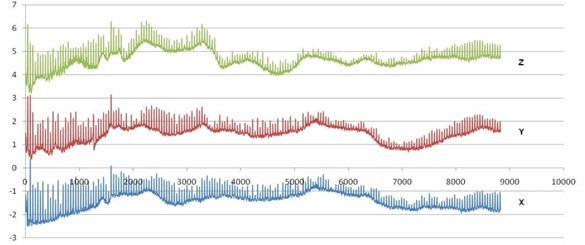
Fig. 3Vibration spectrum of the N2 Ricor K508 electric cooler along the X, Y and Z axes
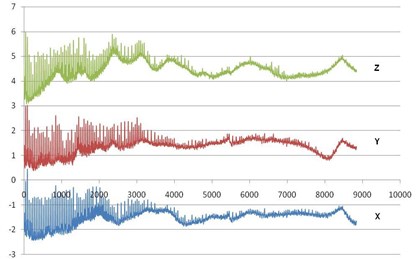
Fig. 4Vibration spectrum of the Thales RM3 electric cooler, along the X, Y and Z axes
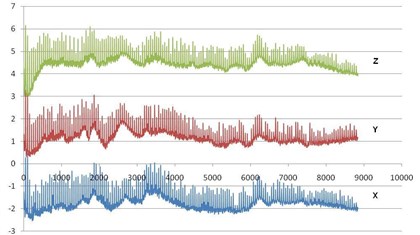
Fig. 5Vibration spectra recorded from the coolers N1 Ricor К508, N2 Ricor K508, Thales RM3
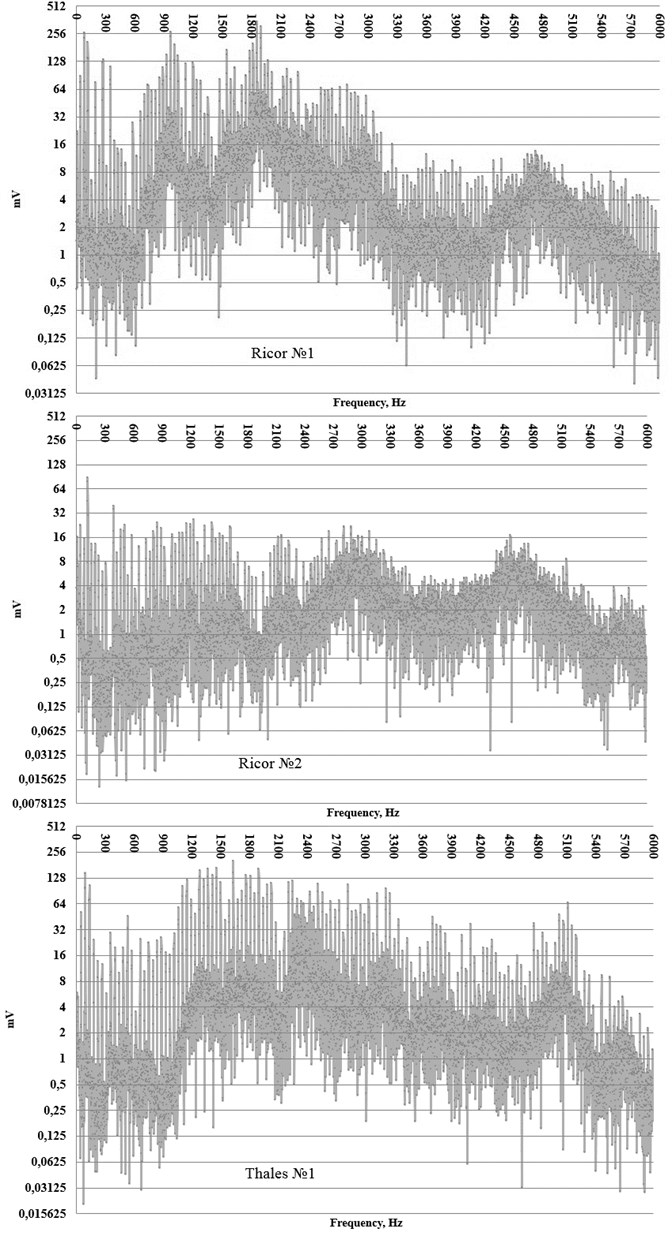
3. Conclusions
In spite of the limited number of the coolers tested, we can conclude that there are significant differences in the vibration characteristics between the various types of coolers and between coolers of the same type. A comparatively simple inspection of characteristic vibration levels was done by us in the laboratory. To categorize the vibration characteristics of the coolers we have developed a vibration test bench that utilizes a wideband microphone and a ZET 110 spectrum analyzer. The results obtained in our laboratory follow the same trends and give the same ranking as the test results obtained in the Vibroacoustic laboratory.
References
-
Sokolov A. D., Pchelintsev А. B., Gostilo V. V. The analysis of electric coolers performance for gamma-radiation HPGe detectors. Nuclear and Radiation Safety, Kiev, Ukraine, Vol. 4, 2015, p. 45-50.
-
www.canberra.com
-
www.ortec.com
-
www.bsi.lv
-
Goldsten J. O., Rhodes E. A., Boynton W. V., Feldman W. C., Lawrence D. J., Trombka J. I., Smith D. M., Evans L. G., White J., Madden N. W., Berg P. C., Murphy G. A., Gurnee R. S., Strohbehn K., Williams B D., Schaefer E. D., Monaco C. A., Cork C. P., Eckels D., Miller W. O., Burks M. T., Hagler L. B., DeTeresa S. J., Witte M. C. The MESSENGER gamma-ray and neutron spectrometer. Space Science Reviews, Vol. 131, 2007, p. 339-391.
-
http://www.ricor.com/wp-content/uploads/2013/05/K508.pdf
-
Pchelintsev А. B., Lupilov А. V., Nurgaleev R. M., Jakovlev О. I., Sokolov А. D., Gostilo V. V., Owens A. Miniature HPGe spectrometer for space applications. Cosmic Research, Russia, (in Press).
-
https://www.thalesgroup.com/sites/default/files/asset/document/rm3_leaflet_2015_0.pdf
-
http://www.ddcentrs.lv/index.html
-
http://www.latak.lv/index.php?lang=en
About this article
The authors thank the specialists of the Vibroacoustic Measurements Laboratory of the Diagnostics and Design Centre [9] for the responsiveness and execution of the electric cooler measurements in the present work.
The authors are also thankful to specialists of Ricor (Israel) and Thales (France) for their work to read, comment and improve the present article.
